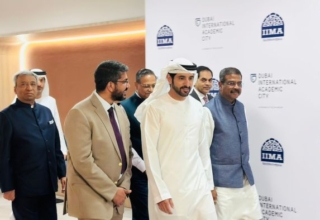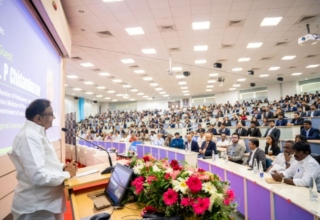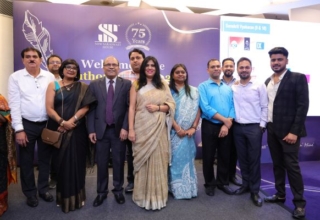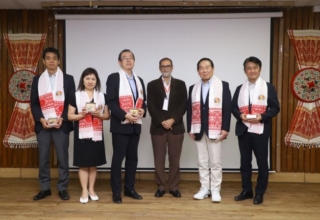
Global relevance & competitiveness remain the key challenge as India will have 70 million students, the highest number ever in history of mankind by 2030
According to Greg Clark, British Minister of State for Universities, Science and Cities, soon one in four students globally will be an Indian and so world can’t ignore India. Conversely, India would also greatly depend on quality human capital export to stay relevant to the world. The failure of Indian institutions to break in the top 200 world universities despite possessing the largest higher education system in the world, calls for leapfrogging systemic handicaps to become relevant and competitive while providing well-rounded education to India’s masses and promoting research-focused institutions. 10th FICCI Higher Education Summit 2014 snap shots
EVERYBODY INCLUDING the government concedes that higher education, which was once famously dubbed as ‘the sick child of Indian education’ by Arjun Singh a former union HRD minister, continues to be an area where challenges exist in abundance. Satyanarayan Mohanty, Secretary, Department of Higher Education, while speaking at the 10th FICCI Higher Education Summit 2014 (held on Nov 13-14 in New delhi) emphasized the need for providing quality learning across all educational institutions in India as quality education has emerged as one of the daunting challenges for the country. The educational institutions must become drivers of quality. Mohanty said that the education DNA of the country needs to undergo a sea change and the focus must shift from doling out degrees to value for money. He stressed that education must make a person employable.
Smriti Irani, Union Minister for Human Resource Development, who released FICCI-EY Knowledge Paper on the theme ‘Higher Education in India: Moving towards Global Relevance and Competitiveness’ during the inaugural plenary said, “I look upon education as an opportunity to redefine India’s destiny and am happy to note that in the last six months we have undertaken a review of all regulators in the field of education to redefine the way forward and ascertain the needs of the future.” She also announced that choice-based credit system is being implemented across central universities for student mobility from work to classroom and cities. She also mentioned MOOCs under SWAYAM, which are free of cost. To address the issue of quality in higher education, the Government has announced GIAN (Global Initiative for Academic Network) inviting industry experts and academicians world over to teach in different Indian universities. And as a bottom up approach to improve quality, Government will roll out the ‘Rashtriya Avishkar Abhiyan’ next year with a view to arresting the falling trend of learning outcomes in mathematics and science of students in classes 6-8 and upgrade the skills of teachers in line with the needs of modern-day society. She also talked about universities adopting and developing rural areas and soon to be rolled out Madan Mohan Malviya Teachers Training Program.
Dr. (Ms.) Jyotsna Suri, President-elect, FICCI, outlined FICCI’s view. FICCI’s Vision 2030 for higher education in India proposes a three tiered higher education system representing research focused, career focused and foundation institutions. This differentiated approach will offer students a wider variety of unique and quality programs at both graduate and undergraduate levels. This way, while planned expansion will create capacity for the ever increasing numbers of students, the differentiated system will be instrumental in directing them to the right stream and the appropriate institution. FICCI is propounding 10 big ideas including seeing 20 universities in top 200, six Nobel laureates in next 10-15 years.
The knowledge paper prepared by FICCI-EY suggests key imperatives to realize this vision such as developing higher education institutes with an international outlook and global impact; providing world-class teaching, research and conducive learning environment; relaxing complex regulatory requirements; incentivizing transnational education; developing skilled, job-ready and productive graduates; enabling higher education graduates with global skills, who can be employed by or serve workforce-deficient countries; developing research-focused universities that deliver high-quality research output and research-focused graduates; increasing R&D funding by Government, promoting increased industry participation in research and innovation and creating a conducive educational, financial and regulatory ecosystem to promote entrepreneurship.
It notes that the global economy is undergoing structural transformation. There will be need for a workforce of 3.3 billion by 2020, increasingly in the services and capital intensive-manufacturing sectors. The phenomena is also expected to play out in India by 2020, 90% of India’s GDP and 75% of employment is expected to be contributed by the services and manufacturing sectors. Technological advancement will make several jobs redundant while also creating new job roles. This structural shift in employment will increase demand for sophisticated workers, innovators, and thinkers who can thrive in a globally-connected and dynamic economy. India, with its large workforce and increasing pool of higher education graduates, is strategically positioned to reap the benefits of this shift. However, the ‘demographic divided’ will be squandered unless India is able to create a “globally relevant and competitive” higher education system that serves the requirements of both the domestic as well as global economy.
The FICCI-EY paper also points our low employability of graduates, driven by several factors including outdated curricula, shortage of quality faculty, high student-teacher ratios, lack of institutional and industry linkages, and lack of autonomy to introduce new and innovative courses; low impact research output and patents filed given relatively low government and corporate spending on research, insufficient doctoral students, missing research focus and culture in most institutions, and lack of international research collaborations; limited focus on entrepreneurship on campus as reflected in the fact that there are few institutes that offer programs in entrepreneurship and have active incubation / entrepreneurship cells and complex regulatory requirements and hurdles, poor institutional governance standards, and lack of professional management. The paper says snstitutions, on their part, would need to adopt a transformative and innovative approach across all levers of higher education: from curricula and pedagogy to the use of technology to partnerships, governance and funding, to become globally relevant and competitive.
Taking a dig at the regulatory role of UGC, Dr. Arvind Panagariya, Professor of Economics & Jagdish Bhagwati Professor of Indian Political Economy, Columbia University, USA called for its abolishing along with other councils. “The university system in India is more than 160 years old and yet we are nowhere in global ranking. Both quantity wise (GER) and quality wise, India is doing poorly. China started from scratches in 1980s and see how far ahead they are (28% GER vs 21% India), even Brazil and Philippines are much further on. The US higher education system is robust because it is enormously competitive. India needs diversity, freedom and unshackling of private sector and not UGC or central control.”
Dr. Bibek Debroy, Chief Economic Consultant, FICCI and Research Professor, Center for Policy Research, who also spoke at the conference even went further and said there was confusionbeween regulation and control and called for abolishing even the MHRD as according to him most of the higher education institutions are junk because they have not been allowed to be efficient or competitive. “The system allows funding of teachers who don’t teach. As the GER increases, the students will begin to demand those reforms,” he warned.
According to Mohanty persistent problem that the government faced was the legacy challenge – whether education is a merit or private good? He said that there was ambiguity on what would be a reasonable surplus after the Supreme Court of India stated that an educational institute cannot run for profit but can make reasonable surplus. Public private positioning of the education sector was being thought through. He added that for higher education to flourish, the government was looking at the options of a free market supply and highly regulated supply. However, Mohanty cautioned that in a free market when an institution would close down, it would render thousands of students without academic qualification who would lose the money that they had invested in their education.
Adding to prevailing view in the government as per additional secretary, Dr Amarjeet Sinha is that there was a need to go for evidence-based approach and in this context the National Law schools offer a model. He said, ministry is examining all frameworks including OECD, Chinese etc as part of New Education Policy spade work. “We are looking at what has worked and why? We have to ensure that small town aspirations and needs are not left out in this whole public private debate.”
The other fierce debate is on research. Several speakers described lack of research in universities as the primary reason for backwardness of Indian higher education. Indian universities are just teaching institutions and most research takes place outside the university system in Indian through various research councils. “Research has been taken away from universities, which is a fundamental mistake. Also, the way we have separate universities for a single discipline is not good. Research needs multidisciplinary environment and it is this relationship that would ultimately produce something good for society and community, for whose benefit is ultimately. Also, while several of us have international collaborations, a similar enthusiasm or practice domestically is totally amiss,” says Dr Vasudeo Gade VC Pune University. ‘You need a national research fund to encourage universities of all hues take on research as also a national scholarship fund for seamless flow of deserving students,“ adds Dr Kavita Sharma, president South Asian University and former principal of Hindu college. The pattern of funding is highly discriminatory at present with state universities which constitute the bulk 80% of higher education in India not getting comparable grants with central universities and private universities almost as untouchables. According to secretary department of Science & Technology, Dr K Vijay Raghavan, there is a need for bottom up drive for excellence.
The government meanwhile has decided to set up a council for higher education and industry interface and it has also set up a committee for identifying 10 grand challenges in research & development (R & D). According to Amita Sharma, a former MHRD additional secretary, industry-academia interface should boil down to secondary education level to make a real impact. Nikki Randhawa Haley, Governor of South Carolina, USA, while saying that . “We hope to see a deepening of the student exchange programme with India and always look to support partnerships in education with India,” had a lesson for Indian higher education system. She said that institutions in her state not only train for skills but for culture as well thereby allowing the organization culture of the country of origin to remain intact while foreign companies set up operations in South Carolina.
Teacher shortage, which is being felt across the education sector and obviously it, also came up for a discussion at the conference. According to Prof R Govinda, faculty is not a monolith; low-end existence in small towns is a different and disengaged world together. “We have narrowed down on teacher. S/he is burdened and under technological stress and big pressure. We don’t have faith in our people while as fact is we had great institutions and teachers without the frameworks we are now talking about. There are no incubations for teachers?” he added. Prof Sanjay Dhande, former IIT Kanpur director opines, “The mandatory PhD provision for being a teacher (in higher education) is a conspiracy by the academic world. You can enter the profession only after 30 years is not sync with other professions. You need to create positions where young with passion to teacher can enter and progress.Recruitments have suffered from bureaucratic delays and let’s ensure transparency.” According to Prof gary A Tubb, faculty director at the University of Chicago, “ You need to know the difficult reasons that force Indian teachers to move abroad and probably that will also hold some answers to teacher issues here. There is a connection between research and teaching, the dynamic processes. That your laws don’t allow foreign faculty to be taken as full time may also need to change.”
Prof. Craig Calhoun, Director, London School of Economics, UK, in his keynote address, said that Indian higher education was a t cross-roads as Indian society is changing with economic growth in response to global changed relations. India faces contradictory challenges. There is need to create an educational ecosystem in India. The ecosystem would be a combination of all types of educational institutions in the country and could work in tandem to cater to different set of students, fulfilling their aspirations. He added that India needs as sustained growth cycle of 7-8 % for moving forward and education was an essential component for growth. Indian universities need to be open to entrepreneurial creativity and offer hand holding to tiny businesses.
The end objective of higher education shake up as envisaged in FICCI-EFY vision will be to see India prominently placed on the global higher education map in terms of more globally-reputed Indian institutions, significant student and faculty mobility, presence of / collaborations with quality international institutions. India as a hub for talent that is able to drive competitiveness of the Indian economy and is fit to work in or serve international markets. And, more importantly, fostering a culture of research, innovation and entrepreneurship in universities and institutions that can power high economic growth in the country.








